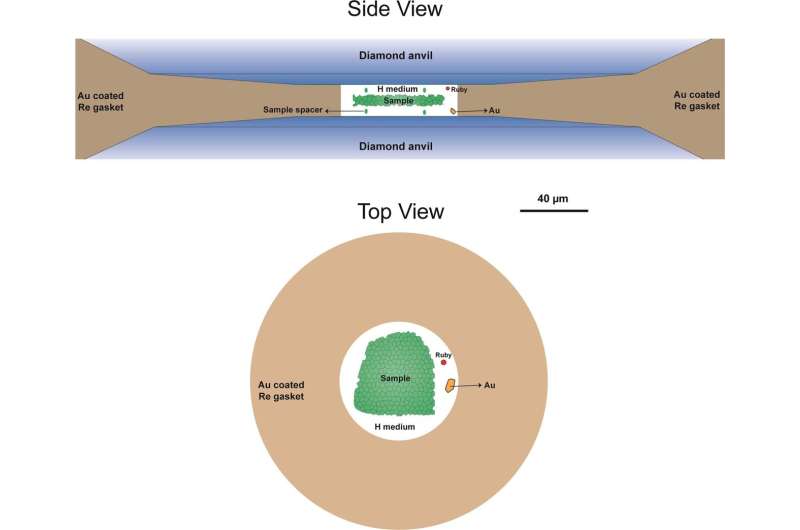This article has been reviewed according to Science X's editorial process and policies. Editors have highlighted the following attributes while ensuring the content's credibility:
fact-checked
peer-reviewed publication
trusted source
proofread
Rising silicon-rich snow in the Earth's outer core

Deep below the Earth's surface lies the outer core, which is made up 2000-km thick liquid iron alloy layer. Despite being located 3000-km deep from the surface, it still affects our surface habitability as it is the region where Earth's magnetic field is generated.
In a study recently published in the journal Nature a team of scientists, including Sang-Heon Dan Shim and Suyu Fu of Arizona State University have completed experimental observation of silicon-rich crystal formation in iron-hydrogen alloy liquid at high pressure and high temperature conditions expected for the Earth's outer core.
Crystals predict snow
The crystals contain enough silicon to be lighter than the liquid and therefore the crystals will rise in liquid iron metal.
For this experiment, lead author Fu, former ASU postdoc now at University of Tokyo as a Postdoctoral Fellow forJapan Society for the Promotion of Science and Shim, of ASU's School of Earth and Space Exploration and Navrotsky Professor, with Stella Chariton and Vitali Prakapenka, both of University of Chicago, focused their laboratory observation, to predict that silicon-rich crystals may snow in the outer core but instead of sinking they will rise.
"The silicon-rich alloy crystallization was found during our experiments in snowy winter days at Chicago during the pandemic," said Shim. "It is interesting that such crystallization behavior can lead to rising silicon-rich snow in the outer core."
For this experiment, iron-silicon alloy is loaded in a hydrogen-argon gas mixture at ASU. Then the samples were compressed to the pressures expected for the core in a diamond-anvil cell. While being held at high pressure, the sample is heated by laser beams to temperatures expected for the core at the Advanced Photon Source, a U.S. Department of Energy (DOE) user facility at DOE's Argonne National Laboratory, where the researchers can monitor crystallization in a diamond-anvil cell using extremely bright X-ray beams.
"Creating high enough temperatures for melting of iron alloys in hydrogen at high pressure has been very difficult," said Shim. "The reason is that hydrogen can diffuse into diamond anvils and break them and fail the experiments."
For this experiment, Shim added "our team developed a new method where hydrogen is mixed with argon in diamond-anvil cells. Argon does not react with the sample but suppresses hydrogen diffusion into diamond anvils, enabling us to achieve the extreme conditions in the laboratory."
This phenomenon can make silicon-rich snow piles at the boundary between the metallic core and the rocky mantle where many enigmatic fine-scale structures have been found in seismic imaging studies for decades.
"If silicon and hydrogen are the two main light elements in the outermost core with appropriate abundances, such a rising silicon-rich snow can occur," said Fu.
Indeed, among those structures, the core-rigidity zones (a few hundred meters thick with solid like properties in the liquid iron metal outer core) found at the core side of the core-mantle boundary may be the silicon-rich snow piles.
If the convecting mantle flow can capture some of these rising silicon-rich crystal snows they may appear as a fine-scale structure with very low seismic velocities at the lowermost mantle, which can explain the ultralow velocity zones documented in seismic studies for decades in the region.
Fu said, "our study also predicts that the silicon-rich snow starts at the outermost-core region and can develop into greater depths with further secular cooling of Earth."
More information: Suyu Fu et al, Core origin of seismic velocity anomalies at Earth's core–mantle boundary, Nature (2023). DOI: 10.1038/s41586-023-05713-5
Journal information: Nature
Provided by Arizona State University





















